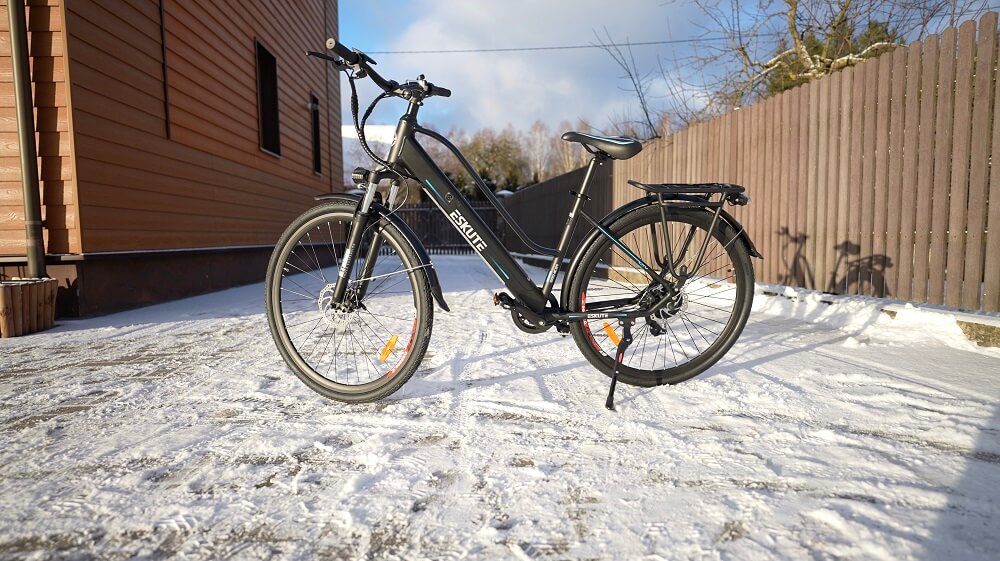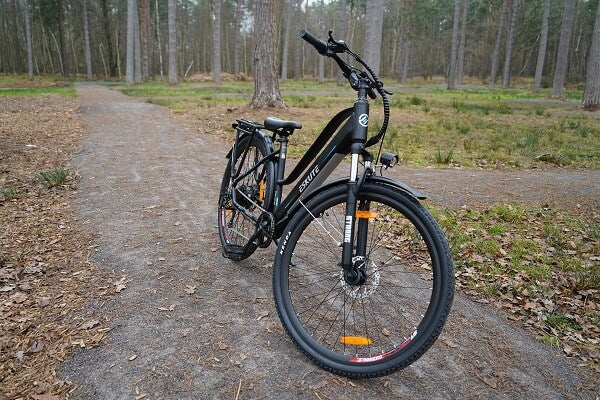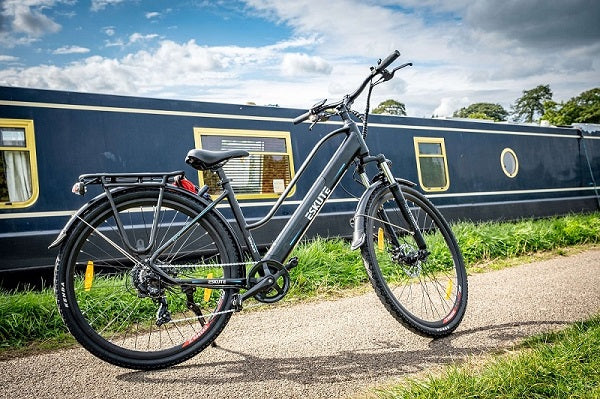Navigation
1. Introduction
As an e-bike rider, it is customary to worry about the safety when riding e bikes in winter during frigid temperatures. Once winter rolls around, you might find that you are unmotivated to keep your e bikes running. Aside from the chilly weather, the gritty and sodden trails, your bike could be susceptible to damage.
Winter is unpredictable, and when the temperature begins to drop even further, you start to ask the one question on every e-bike rider’s mind. “Can I ride e bikes in winter?”
The straightforward answer to that question is “Yes.” Your e-bike is indeed stronger than you are giving it credit for, and it has an impressive level of resilience to it. Although hub motor and mid-drive e-bikes are typically designed to withstand nearly anything come rain, sunshine, and snow, they are all weather electric bikes. Mid-drive motors are much more resilient in wading through inches of snow. From your bike’s battery to the tires and even your handlebars, there is much to consider and take care of before you venture out into the cold. Overall, riding e-bikes in winter is dangerous. Keep the following tips in mind.
2. Safety First
2.1 Check Your E-Bike Before Riding
Before you do anything else, you must check your e-bike. Of course, this is a habit that every good e-bike rider should possess, but it needs reiteration for this particular weather-related circumstance. To make sure that your e-bike is safe to hit the road, check the following:
YOUR WHEELS
Your wheels are undoubtedly one of the most essential parts of your e-bike. After all, you wouldn’t be able to move without them. Pay close attention to the seating of the wheels and make sure that the hardware that holds the axle in place is tight and secure enough.
This is vital because a loose axle or bolt can be further loosened by road vibrations.
BATTERY
Check your battery and make sure it is securely in place. If it is not, it’s best to remedy that instantly or call for professional help if you do not know how to. Hitting the roads with a battery that isn’t secure could lead to intermittent power or the battery falling out entirely! Gently tug on the battery to ensure that it’s snug. If you discover that it comes undone while still locked, this indicates a fault with the installation. Remedy this before going for a ride as well.
LIGHTS AND SOUND
Ensure that your bike lights are functional and bright enough. For extra safety, you may install additional lighting on the spokes of your wheels. The goal is to stay visible and audible for everyone else on the road to notice you. Install both a bell and a horn for complete protection sound-wise.

2.2 Avoid outdoors thrilling adventures
If you can, avoid going on extraordinarily long or challenging outdoor adventures with your e-bike. While you might be excited to explore those frozen trails and paths, it is safer to stick to familiar and less-tasking roads. This way, you can still enjoy the thrill of riding your bike during winter without risking a disaster.
2.3 Don't ride on icy or snow-covered paths
Ice can prove hazardous for e-bikes, and so does snow. While cars have the upper hand with 4-wheel stability, it’s just you and your two wheels against the harsh snow/ice. If you can, avoid ice-covered paths and steer clear of snow too. If there are no other paths for you to ride on, avoid riding all together or get your tires studded for better traction.
3. Keep Yourself Warm
3.1 Equipment
The thin line between a bad accident and one that you walk away unscathed from lies in the kinds of equipment that you wear. For winter riding, staying warm and staying protected is a vital part of enjoyable rides. Dressing warm and safe includes wearing a helmet and other appropriate clothing. Don’t forget that frostbite is a serious condition, so you best keep those arms and legs tucked underneath warm clothes.
- Helmet
Most bike riders already have and wear a helmet while riding. Besides keeping your head safe from injuries in accidents, helmets are also great at keeping your head warm. To help your helmet provide better warmth, wear a hood before putting the helmet on. This tip is especially for helmets that do not have built-in insulation.
- Gloves
Your hands are not only exposed to cold air, but they also hold on to your cold handlebars. Winter poses many issues when riding, and frostbite is the last thing you want to have. Water-resistant gloves should quickly become your best friend in this weather. Ensure that they are thick enough to ward off the chill but flexible enough so that you can have a good grip while using your brakes and shifters.
- Bar Mitts
Another way to protect your hands is to invest in some bar mitts. You can mount bar mitts on your handlebars, making it less damaging to wear lighter dexterous gloves.
- Leather Jacket
It’s important to wear thick clothing while riding in this weather. You could opt for jumpers or other alternatives. However, an excellent option to consider is a leather jacket. Not only do they look great, but they are also excellent at providing insulation.
- Scarves
One area the riders often forget is the neck. While you could go for a good old-fashioned scarf, a neck gaiter or balaclava would be better suited to your outfit. If you hate the cold and don’t mind the “bank robber” look, go all-in with a ski mask.
3.2 Warming-up exercises before riding
Before you start any sport or exercise, it is important to warm up properly. This is no different when you have an e-bike. Doing a couple of warm-up exercises could help with endurance and stamina, thus allowing you to enjoy your ride better. Stretches and exercises include:

- Jumping Jacks: As one of the most common warm-up exercises, jumping jacks are great for loosening up your entire body simultaneously.
- Static Stretches: These include you holding stretches for an extended period.
- Dynamic stretches: Dynamic stretches involve making repetitive motions alternatively to warm up your joints and boost your range of motion.
- Butt kicks: these are great for loosening up your hip flexor and thigh muscles. Butt kicks also work great for preparing these muscles for the rapid movement of cycling.
- Leg Swings: Cycling for a long while tends to create stiffness and tension in the hip region. To get ahead of this, do leg swings outward and backwards to improve mobility at the hips.
- Lunges: Lunges also help with relieving and preventing tightness in the hips. They also help strengthen your hamstrings, thighs, and quads, thus effectively boosting your speed and endurance. There are variations of lunges that you can include in your pre-cycling warm-up routine, like walking lunges and sidestep lunges.
- Squats: while squats are more known for building muscle, they also benefit riders. Squats engage nearly every muscle group in your body, especially muscles at your hips, thighs, and legs. You can either do squats with your bodyweight or with some form of added weights like barbells or dumbbells.
4. Maintain Your e-bike
4.1 Equipment
It is essential to keep an eye on every part of your e-bike. Conduct frequent checks before and after every ride to ensure that everything is as it should be.
- Extra Bike Lights
As an e-bike rider, your safety motto should be “see and be seen.” While you prioritize your path being properly lit for your benefit, do not forget other road users. Other road users often miss bike riders, especially at night or in other low-light conditions. Extra bike lights fitted all around your bike help you and other road users stay safe. In light of this, reflective tape is a great way to “be seen.”
- Mudguard
Proper maintenance includes having a mudguard to keep off as much snow, ice, and dirt. Mudguards keep you and your bike clean and dry, so you don’t have any snow or ice weaselling its way into intricate parts of the bike.
4.2 Tyres
Keep right pressure
Your tyres must be well suited to the kind of riding that you do, especially in the winter. When riding on ice or hard-packed snow, use slimmer tires preferably fitted with studs. These can cut through the terrain easily. For otherwise loose snow, opt for fat knobby tires to have increased air volume and less pressure.
Change your Winter Tyres
Depending on how frequently you ride and how rough the rides are, your winter tires might need more frequent changes or less. Frequently inspecting your tyres lets you know when they need to be swapped. Avoid letting them wear out for too long before changing them. Signs to look out for include:
- Signs of wear and tear in thread
- Cracked rubber
- Recurrent flats
- Any cuts or holes
- Any bubbles or unusual deformities
Storage
When not in use, ensure that your bike is properly stored and sheltered from the elements. Keep it in a dry shelter, preferably covered with a tarp or any other protective material. Keep your e-bike in an upright position for proper drainage. Do not leave your bike out in the snow or ice. If you happen to do so by accident, wipe down with anti-rust treatment on the chain and other steel parts as soon as you remember.
4.3 Battery
Charge at room temperature
Charge your battery when necessary but avoid doing so in freezing or below-32F (below-zero) temperature. Charge your bike at room temperature
Storage
Avoid leaving your battery outside in the cold for a long time. This is the most critical mistake many unknowing riders make. This always shortens the efficiency and lifespan of a battery. If your bike’s battery is removable, simply remove it and store it inside in a cool, dry place. Note that you should not keep your battery with a full charge. 40-48% charge range is just about suitable for storage.
Battery replacement
If you want riding e bikes in winter for a longer journey, prepare battery replacement in advance is a wise choice, especially for those riding for travelling. But different e bikes have their own specifications, so make sure your voltage and watt per hour before purchase.
4.4 Brakes
Braking in the winter is significantly different. You should never forget that stopping distances are longer in the winter and mechanical brakes are far more susceptible to the effects of snow and ice.
The water from melted snow and ice can get into brake houses where they freeze and affect a bike’s braking power. Use a few drops of deicer in the brake housings every couple of weeks. Alternatively, you can invest in e bikes with hydraulic brakes. Ensure that you check the cables and levers for rust, tears, and other signs of wear and tear. Immediately remove and repair when needed.
4.5 Clean regularly with suitable lubricants or lighter, wet lubricants
As earlier stated, a clean e bike is a fast bike. Your bike gathers tons of dirt and mud while you’re out and about, and during winter, the elements are incredibly unforgiving. Keep the drivetrain free of dirt and grease to ensure its smooth running. An easy way to clean your e-bike drivetrain is with a rag and water with mild detergent for wiping down the frame or with a degreaser for deeper cleaning.
You should clean according to how often you use your bike, considering the kinds of terrains you explore. Use all-season lubricants for your bike’s cogs, chainrings, and chain. Avoid dousing these parts with excessive amounts of lubricant.
4.6 Use of Anti-rust spray
Although your bike might face the dreariest of weather, you still need to worry about rust. While most of them use rust-resistant components, many areas are susceptible to the elements. Rusting bike parts and corrosion often lead to minor and major accidents on the road. Avoid either of these by investing in an excellent anti-rust spray for your bike.
5. Best All Weather Electric Bikes (recommend ESKUTE voyager pro)

The best e-bikes that have your e bike no matter the weather is far and few in between no matter the weather. Here is my recommended best all-weather bike you can ride during winter without any worries.
ESKUTE Voyager Pro with pros:
- Mid-drive motor excellent for riding in tricky terrains
- Comfortable ride
- 540Wh battery capacity
- Maximum estimated range of 60 Miles
- 9-speed type gear system
- 5mph speed










Leave a comment
This site is protected by hCaptcha and the hCaptcha Privacy Policy and Terms of Service apply.